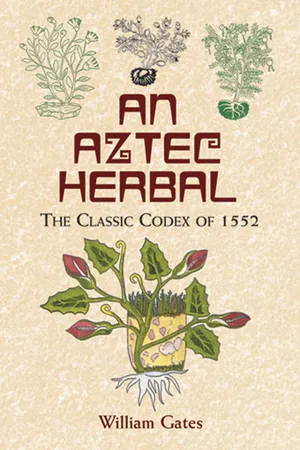
- 192 pages
- English
- ePUB (mobile friendly)
- Available on iOS & Android
About this book
"I love that this book is the real deal. A truly unique and informative read." — Texas Kitchen and Garden and More
Originally written in the Aztec language, Nahuatl, in 1552, this classic codex was the first herbal and medical text compiled in the New World. The author of this extraordinarily rare and valuable document was Martín de la Cruz, an Aztec physician, whose work was subsequently translated into Latin by an Aztec nobleman, Juan Badiano.
The book was translated into English in 1939 by William Gates. In these pages are centuries-old Aztec remedies for boils, hair loss, cataracts, insomnia, sore throats, hiccups, gout, lesions, wounds, joint diseases, tumors, and scores of other ailments. Over 180 black-and-white figures of the plants augment the text, along with 38 full color illustrations made specially for the Gates edition. Additional supplements include an introduction to the Mexican botanical system, an analytical index of the plants, and a new Introduction by anthropologist Bruce Byland of the City University of New York.
Remarkable for its scope, detail, careful observation, and accurate description, An Aztec Herbal stands as a magnificent example of the impressive medical knowledge of indigenous peoples. This handsome and inexpensive edition of a long-unavailable work promises to engender a new appreciation of the skill and inventiveness of Aztec medical practices in particular and of Native American science in general.
Frequently asked questions
- Essential is ideal for learners and professionals who enjoy exploring a wide range of subjects. Access the Essential Library with 800,000+ trusted titles and best-sellers across business, personal growth, and the humanities. Includes unlimited reading time and Standard Read Aloud voice.
- Complete: Perfect for advanced learners and researchers needing full, unrestricted access. Unlock 1.4M+ books across hundreds of subjects, including academic and specialized titles. The Complete Plan also includes advanced features like Premium Read Aloud and Research Assistant.
Please note we cannot support devices running on iOS 13 and Android 7 or earlier. Learn more about using the app.
Information
Analytical Index to Plants named in Herbal.

Table of contents
- Title Page
- Copyright Page
- Table of Contents
- Introduction to the Dover Edition
- PREFACE
- A LITTLE BOOK
- A Table of what is Contained Herein.
- CHAPTER FIRST: On the curation of the head, boils, scales or mange, coming out of the hair, lesions or broken skull.
- CHAPTER SECOND: Curation of the eyes, heat, the eyes bloodshot, cataract, stupor of the brows or rather lids, tumors, to bring on sleep, to avoid sleepiness.
- CHAPTER THIRD: on festering in the ears, and deafness or stoppage.
- CHAPTER FOURTH : on catarrh, medicine to be put into the nostrils, the blood-stanching plants.
- CHAPTER FIFTH: tooth-polish, curation of swelling and festering gums, aching and decaying teeth with much heat, tumors and suppuration of the throat, angina, medicine to ease pain in the gullet, to bring back saliva when dry, when the saliva comes bloody, to allay a cough, to stop foul and offensive breath.
- CHAPTER SIXTH: for cooling the heat of a swollen jaw, to cure one who cannot yawn for the pain, for scabs on the face or mouth, for scrofulous eruptions on the neck, dropsy, lameness or weakness of the hands.
- CHAPTER SEVENTH: on chest trouble, pain in the heart and heat, pain in the sides, medicine to kill worms and animalcula, antidote for poison, tumor of the stomach, pains in the abdomen, dysentery or griping, rumbling of the abdomen, chill, purging.
- CHAPTER EIGHTH: Curation of the pubis and groin, stoppage of the urine, difficulty in passing, affections of the rectum, gout, pain in the knees, the knees beginning to contract, remedy for cracks coming in the soles of the feet, lesions in the feet, against fatigue, trees and flowers to relieve lassitude in the administrators of the affairs of the state and the public business.
- CHAPTER NINTH: the remedy for black blood, fevers, haemorrhoids, rectal swellings, excessive heat, cuts on the body, ringworm and tetter, recurrent attacks of disease, skin eruptions, wounds, disease of the joints, itch, festering with worms, inflammations, difficult digestion, swelling in cut veins after phlebotomy, those struck by lightning.
- CHAPTER TENTH: on the falling sickness, or epilepsy, the remedy for fear or timidity, a mind unbalanced by a tornado or bad wind, warts, hircine armpit odor of sick people, phthirasis of lousy distemper, lice on the head, for a traveler crossing a river or water.
- CHAPTER ELEVENTH : remedies for recent parturition, the menses, lotion of the internal parts, childbirth, tubercles of the breast, medicine for increasing milk flow.
- CHAPTER TWELFTH: on boys’ skin eruptions, and when an infant refuses the breast because of some pain.
- CHAPTER THIRTEENTH: of certain signs of approaching death.
- Preface to the Analytical Index
- Analytical Index to Plants named in Herbal.